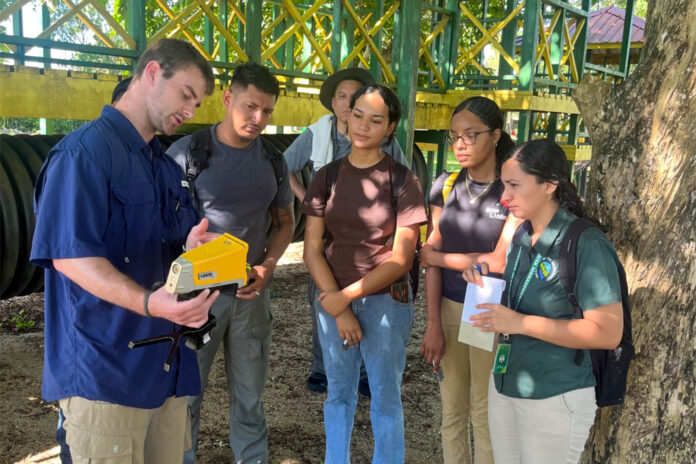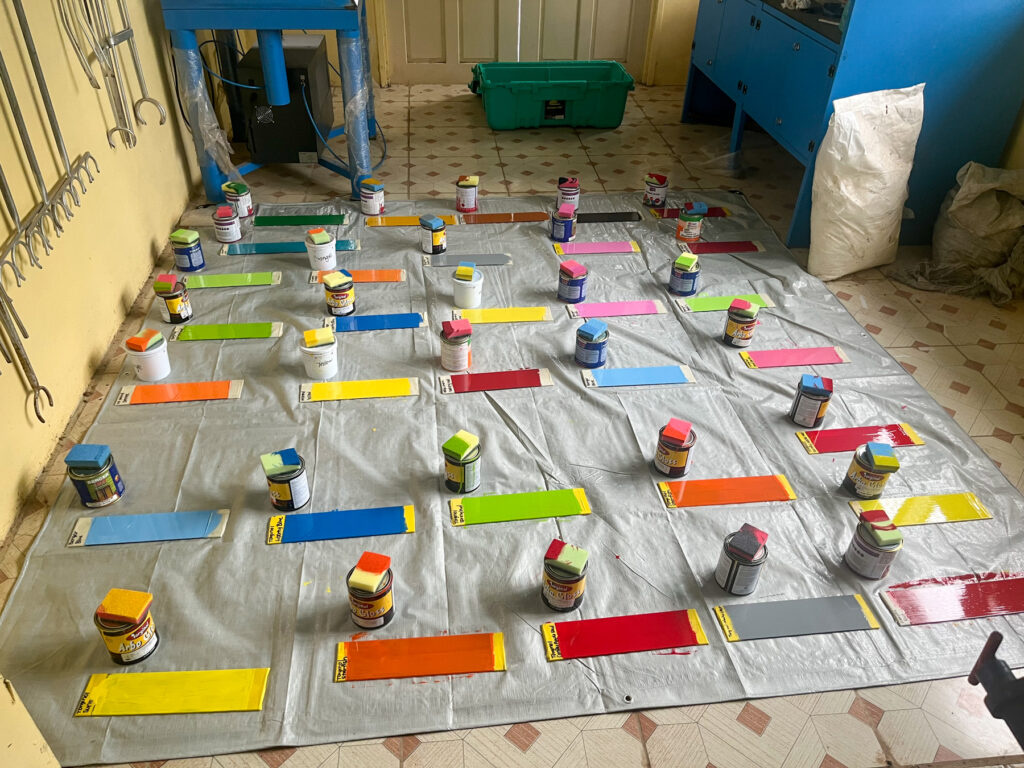
While working to help curb mercury pollution in Guyana, a Mercer University team made another startling discovery.
Many surfaces in the town where the team was working were covered in dangerous levels of lead, said Dr. Adam Kiefer, Distinguished University Professor of Chemistry.
This included playgrounds and school walls. One peeling school desk was found to have over 3,000 times the U.S. standard for lead in paint, Dr. Kiefer said.
And it wasn’t just old paint that contained the harmful heavy metal. The Mercer team found lead in new paint too, including in cans that had been labeled as lead-free and despite a law restricting lead in paint.
“We took the initiative to purchase 10 different paints in the town of Bartica, and we found that a number of them, I believe six in total, had lead in the paint,” Dr. Kiefer said.
Researchers were alarmed. Exposure to lead can cause lead poisoning and seriously harm a person’s health. It is especially dangerous for children, whose mental and physical development may be severely affected.
Typically, the solution would be to paint over old, lead-containing paint with new, lead-free paint. But without knowing if the new paint was indeed lead-free, that could just make the problem worse, Dr. Kiefer said.
The conventional method for identifying lead in paint is time-consuming and expensive, especially for low- to middle-income countries like Guyana.
“There was no capacity in many of these countries to analyze and quantify lead in paint, and so no one knew that it was in new paint,” Dr. Kiefer said.

Since the discovery in 2019, Dr. Kiefer and Dr. Caryn Seney, professor of chemistry, have been developing a faster, less expensive method for countries like Guyana to identify and quantify lead in new paint.
The Mercer team’s newly developed method uses a relatively inexpensive device called a portable X-ray fluorescence analyzer, or pXRF, to offer fast and more economically viable measurements of lead in new paint, Dr. Seney said.
It works by standardizing the pXRF data against a more precise technique, resulting in a relationship to accurately determine concentrations of lead in new paint. This relationship leads to the rapid and quantitative identification of lead without the expense of other protocols required by more conventional methods, she said.
Progress already is being made in Guyana, she said.
“When we first started, officials were really surprised to hear that there was lead in the paint because it was labeled lead-free,” she said. “We were able to collect enough information off of the new paint to show that there was a significant issue and that we could potentially help them to try to remediate the situation. Imports that are brought in could be tested before they make it into the country.”
Officials “were very interested in having those conversations,” she said. “In fact, they actually have their instrument lab set up now so that they can do some of this analysis work alongside us.”
In fall 2023, Dr. Kiefer led a Mercer team to Belize, which does not have any laws related to lead paint. Dr. Addie Buerck, assistant professor of environmental and civil engineering; Dr. Adrian Vasquez, assistant professor of biology; and undergraduate student Ben Stewart traveled with Dr. Kiefer to the country.
The team began a collaborative relationship with University of Belize and Belize Department of the Environment and trained representatives how to screen for lead in paint using the Mercer method.

“The major finding for us down there was they have these little parks that have the body weight exercise equipment on them, and when we screened those, we found really high levels of lead in the paint,” said Stewart, who graduated from the College of Liberal Arts and Sciences in December with a Bachelor of Science in neuroscience. He will attend Mercer School of Medicine in the fall.
The team also found lead in spray paint used to make public art, he said.
The next steps are to determine the scope of the problem and continue training University of Belize representatives, so they may do the work without Mercer, Dr. Kiefer said. This will be done through Mercer On Mission, a signature University program that combines study abroad, research and service-learning.
Meanwhile, “as we continue in the laboratory, what we are really trying to do at this point is find the scope and limitations for the method that Dr. Seney and I have developed,” Dr. Kiefer said. “We want to demonstrate that this less expensive pXRF alternative can be used in lower- and middle-income countries in place of these very expensive, very technical instruments. …
“The key thing is that we don’t want to have them remediate the problem. We want to have them not have the problem. And that starts with knowing what is coming in and being able to rapidly screen things in port before they get to the store shelf.”








